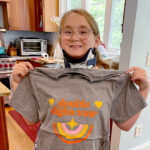Freak accident leads to Dylan’s passion for neurosurgery
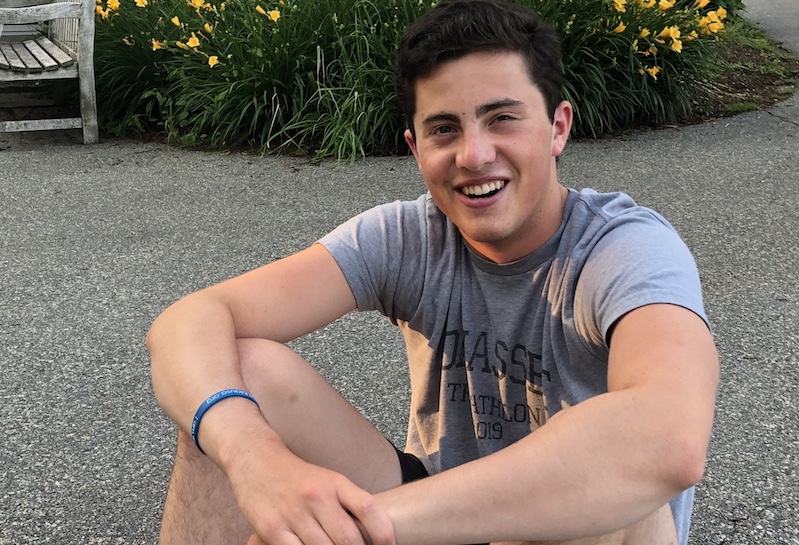
It was the summer of 2019. Dylan Keusch had just graduated from prep school and was planning to major in Industrial Labor Relations at Cornell University in the fall. His life felt pretty perfect. “Everything was going great — I was a national club team swimmer at the peak of my career, I was headed to Cornell to study what I loved, I had amazing family and friends, and I was looking forward to my future,” says Dylan.
Then, one day in July, everything changed. While walking into swim practice with his coach, Dylan suddenly felt like he needed to sit down and then fainted. “I fell straight back and my head took the brunt of the impact,” he says. “I came to several minutes later, and was taken to a local hospital in an ambulance.”
When Dylan got to the hospital, a CT scan showed he had bleeding in the brain. “The lead emergency room doctor pulled my parents out of my room and told them they weren’t able to treat me there, and I needed to go to a hospital with that capability. That’s when I got transferred to Boston Children’s Hospital.”

A move to Boston Children’s
He was transferred by ambulance to the trauma center at Boston Children’s. “The surgeons met me at the door, but they held off on doing a craniotomy [an operation to remove part of the skull to see inside the brain] to stop the bleeding,” says Dylan. “Instead, my surgeon, Dr. Benjamin Warf, and his team, watched my neurological status carefully and kept doing MRIs to make sure the bleeding was under control. I realized later the expertise involved in taking that approach was unparalleled.”
For the first 24 hours of his hospital stay, Dylan was moved to the medical surgical intensive care unit (MSICU). “Those days were some of the toughest my family has ever had,” he says. “I couldn’t stay awake. My friends and family came to visit and I had no idea who they were. I had gone from being a really active teenager to lying almost lifeless in a hospital bed. It was really difficult.”
Over the ensuing weeks, Dylan gradually improved and was able to go home, but he continued to be in a lot of pain and spent a lot of time trying to reckon with his “new normal.”
“I had been a happy teenager able to do whatever I wanted, and now I was home, stuck in bed,” he says. “I kept asking why this had happened to me and what I had done to deserve it.”
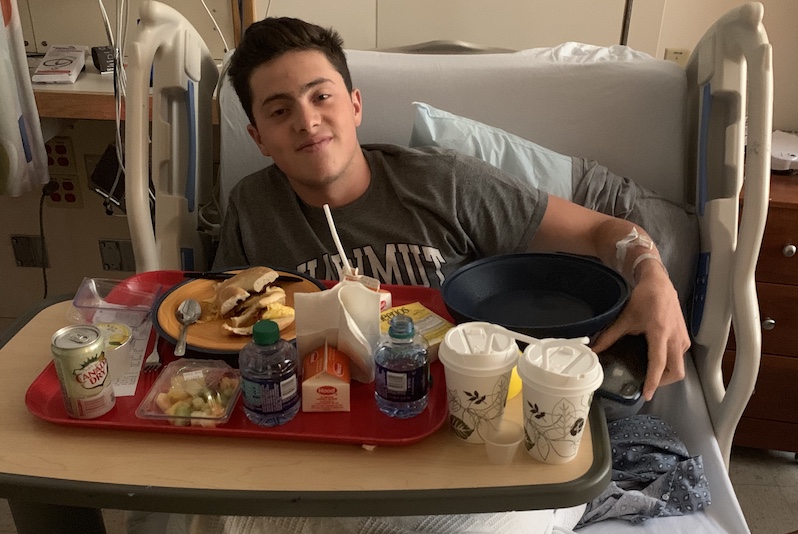
Falling into a darker place
As the summer progressed, Dylan fell into an even darker place. “I was on vacation on Martha’s Vineyard with my family, and even though I was feeling better physically, I spent a lot of my days in bed with the door closed and the lights off, depressed.”
That fall, as the injury was too serious to allow a return to school, he had decided to take a gap year and started doing physical therapy with Danielle Barnack at Boston Children’s.
“I wanted to get back to swimming to prove I could do it,” he says. “Danielle was like a second mother to me, I credit her with getting me back in the pool. I still have the photo of my first day back at the pool taped up on my wall. It was then I realized how far I’d come, and it was due to my incredible team at Boston Children’s.”
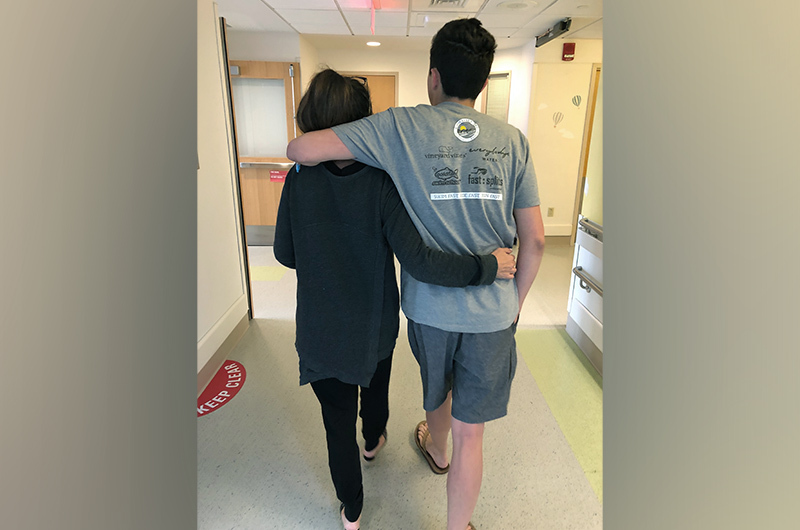
A turning point
Although he didn’t realize it at the time, this moment became a turning point for his future.
During Dylan’s gap year, he had planned to work at a political consulting firm. “I had been interested in politics and law my whole life, and this was an amazing opportunity. But after three weeks of looking at spreadsheets, I just realized I couldn’t do it and quit,” he says.
Instead, he decided to dig deeper into his newfound interest in medicine. A friend of the family offered to show him around the hospital where he was vice chair of surgery. “I told him I just didn’t want a tour of the clinic, I wanted to watch a surgery.” The following week, Dylan was in the operating room, observing a heart surgery. He was hooked.
“It was then that I fell in love with medicine,” says Dylan. “I had a big revelation — life is fragile, and I had no time to waste. I knew I needed to do something big with my life.”
Discovering a passion for neurosurgery
Dylan kept observing, rotating on all types of surgery, from interventional cardiology to vascular surgery. Finally, he observed in neurosurgery. “The first time I saw a brain surgery I was hooked. There was something about neurosurgery that changed everything for me. I had that personal connection to it and I knew immediately that it was what I wanted to pursue.”
Meanwhile, Dylan was also making big advances in the pool. “Exactly 110 days after my injury, I raced for the first time. I won my first event back in the pool. It was probably the most emotional and rewarding moment of my life. Eight months later, I was making national cuts and placing in the top 10 in New England.”
It became clear to Dylan that he was starting to build a new life for himself. “My injury had taught me so much about life and about myself. I’d discovered my passion, and realized I want to spend the rest of my life helping people.”
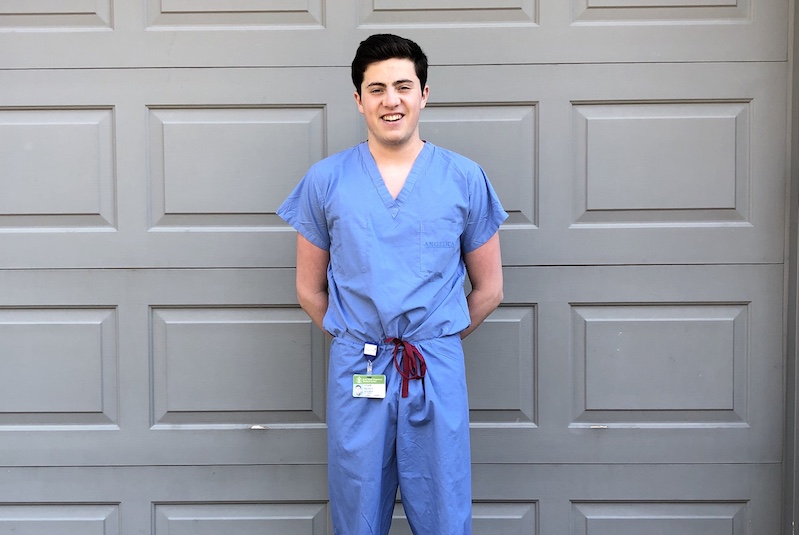
Dylan’s journey comes full circle
Although Dylan still feels the lingering effects of his brain injury, he has continued to move forward with his goals, taking on a schedule many would find daunting. He’s completing his freshman year at Cornell as a pre-med student with a neuroscience focus, training to be an EMT with Cornell’s emergency medical service squad, and is also serving as one of the co-chairs on the Neuroscience Family Advisory Council at Boston Children’s.
‘People always tell me I must be so strong to have overcome all of these obstacles, but I credit my team at Boston Children’s and my family for helping me get to where I am today.”
This coming summer, Dylan’s journey will come full circle as he joins some of his health care team in a professional role. “The culmination of my new life occurred when I was offered a research position in the Department of Neurosurgery at Boston Children’s,” says Dylan. “Having a brain injury was a terrible experience, but it has also taught me so much. It has provided an invaluable perspective for someone my age; a perspective that drives me and motivates me every day.”
Learn more about the Department of Neurosurgery.
Related Posts :
-

What orthopedic trauma surgeons wish more parents knew about lawnmower injuries
Summer is full of delights: lemonade, ice cream, and fresh-cut grass to name a few. Unfortunately, the warmer months can ...
-

A fall from a swing uncovers a rare cervical spine condition: Charlotte’s story
If it were any other year, Charlotte Gillis would have celebrated her 10th birthday in mid-July with a big party. ...
-

MRI could reduce the mystery of brachial plexus injuries in infants
About one in 1,000 children are born with brachial plexus birth injury (BPBI), upper extremity weakness or paralysis resulting from trauma ...
-

For Fiadh: Pushing the envelope to treat drug-resistant epilepsy
Fiadh is a bubbly and empathetic 4-year-old. And if you ask her parents, Elaine and Dario, she’s also mischievous ...



